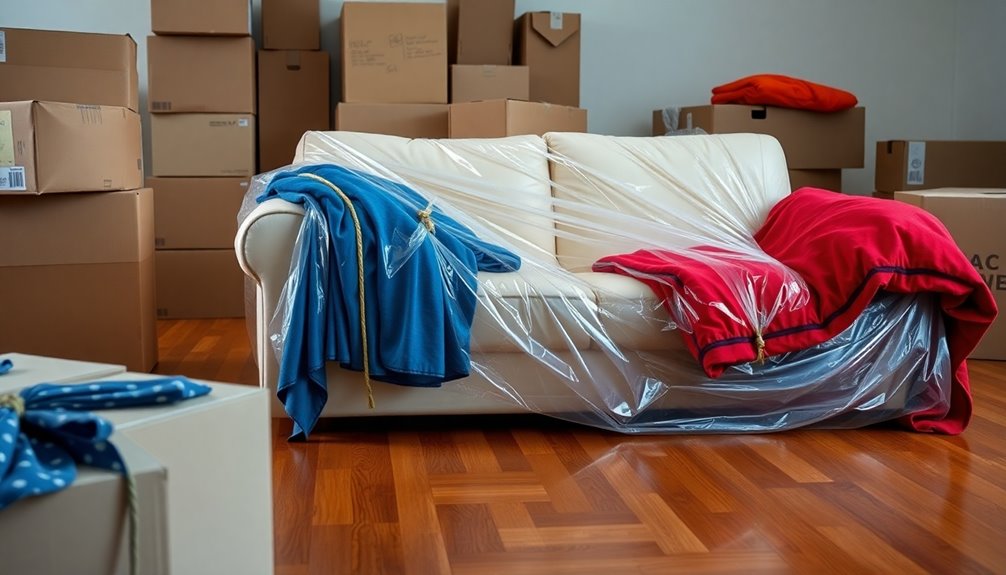To pack your sofa for moving, start by cleaning it thoroughly. Remove cushions and wrap them in vacuum storage bags for easy handling. Protect the sofa by reinforcing corners with bubble wrap or corner protectors. Use furniture pads to cover the entire piece, securing everything with stretch wrap to prevent shifting. Check for any existing damage before moving, and take care to position the sofa securely in the moving vehicle to avoid contact with other items. With these steps, you'll ensure your sofa stays safe during the move. There's even more useful info ahead to help you along the way!
Key Takeaways
- Thoroughly clean the sofa to remove dust and allergens before packing, ensuring it stays fresh during the move.
- Remove and individually wrap cushions using vacuum storage bags for space-saving and protection.
- Use furniture pads and bubble wrap to shield the sofa from scratches and potential damage during transport.
- Inspect the sofa for pre-existing damage and reinforce corners with padding to minimize impact during moving.
- Secure the wrapped sofa in the moving vehicle to prevent shifting and contact with other items.
Introduction
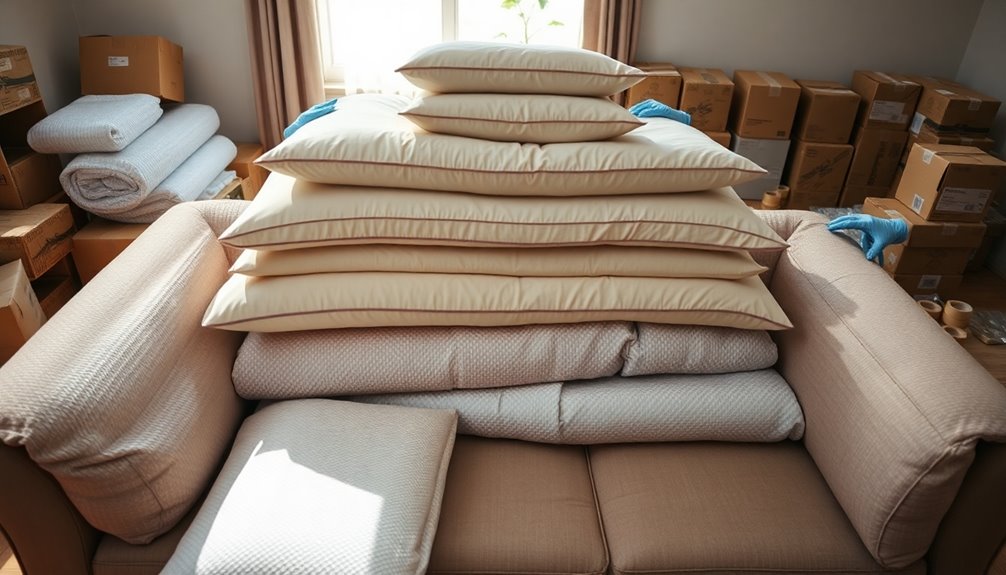
Before you pack your sofa for moving, it's essential to give it a thorough cleaning. Regular dusting and vacuuming, along with fabric-specific cleaning techniques, can help maintain its appearance. Don't forget to tackle any wine or pet stains to ensure your sofa looks its best in your new home.
Routine Dusting and Vacuuming
Routine dusting and vacuuming are essential for keeping your sofa looking its best. Regular dusting helps remove allergens and dust particles from the surface, contributing to a healthier indoor environment. To start, go ahead and grab a microfiber cloth, as they effectively trap dust without scratching the fabric. Wipe down the entire surface, including the cushions and armrests, ensuring no area is overlooked.
Next, incorporate vacuuming into your weekly cleaning routine. Using a vacuum cleaner with an upholstery attachment is ideal, as it allows you to reach all surfaces, including crevices and seams where dirt can accumulate. Keep in mind that preventing the buildup of dirt and debris not only maintains your sofa's appearance but also prolongs the life of the upholstery.
Fabric-Specific Cleaning Techniques
When it comes to maintaining your sofa, understanding fabric-specific cleaning techniques is crucial. Each type of fabric has unique needs that, if not met, can lead to damage. For instance, cotton can often be cleaned with water-based solutions, making it relatively easy to maintain. In contrast, silk requires dry cleaning to preserve its delicate texture and sheen.
If your sofa is upholstered with leather, opt for a pH-balanced leather cleaner and make sure to condition it regularly to keep it supple. Microfiber sofas are a bit more forgiving; you can clean them with a damp cloth and a mild detergent, but remember to test any cleaning solution on a hidden area first to avoid discoloration.
For synthetic fabrics, like polyester, regular vacuuming is essential. Spot cleaning with a mixture of water and vinegar can effectively tackle stains without compromising the material. Always refer to the manufacturer's care tag for specific cleaning instructions tailored to your fabric type. By following these guidelines, you'll not only preserve your sofa's appearance but also extend its lifespan.
Tackling Wine and Pet Stains
Even with the best cleaning techniques, accidents happen, especially when it comes to wine spills and pet mishaps. When you face a wine stain, act quickly. First, gently blot the area with a clean cloth to absorb as much liquid as possible. Then, mix equal parts white vinegar and water and apply it to the stain. This solution helps neutralize the color, making it easier to remove.
For pet stains, immediate action is crucial. Grab an enzymatic cleaner specifically designed for pet messes, as it breaks down both the stain and the odors. Make sure to follow the product instructions closely for the best results. To further control pet hair and reduce the likelihood of future stains, consider implementing regular grooming to minimize shedding.
Before trying any cleaning solution, always test it on a hidden spot of the fabric. This step helps you avoid discoloration or damage to your sofa. Remember, when tackling stains, don't rub the fabric; this can spread the stain and ruin the fibers. Instead, gently blot from the outside in.
To prevent future mishaps, consider using fabric protectants regularly. They create a barrier that makes it easier to clean up spills and minimizes the chances of permanent stains.
Sofa Corner Reinforcement Techniques
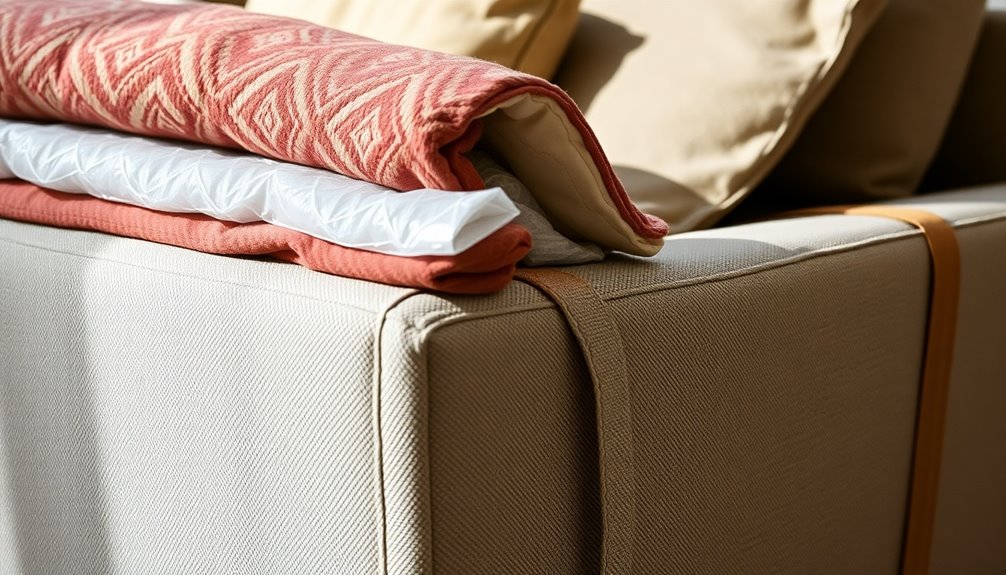
When packing your sofa, selecting scratch-resistant fabric can protect against wear during the move. You might also want to consider decorative fabric protection options to maintain its appearance. Plus, minimizing friction at the edges can help prevent unsightly scuffs and damage.
Scratch-Resistant Fabric Selection
To ensure your sofa withstands the rigors of moving, selecting scratch-resistant fabrics is crucial. Opt for materials like microfiber or leather, which boast durability and resistance to wear and tear. These fabrics will help your sofa remain in great condition, even during the challenges of transport.
In addition to choosing the right fabric, reinforcing the corners of your sofa is essential. Use extra padding or corner protectors made from foam or cardboard to absorb impact and prevent potential fabric damage. This added layer of defense can make a significant difference during the moving process.
Once you've secured the corners, wrap them with stretch wrap to create a protective barrier that minimizes exposure to scratches. For even more protection, consider adding a layer of bubble wrap or packing blankets around the corners before wrapping. This extra cushioning can guard against bumps and scuffs that may occur during transit.
Finally, don't forget to inspect your chosen fabric for any existing damage before moving. Pre-existing issues can worsen if not properly reinforced, so addressing them ahead of time will help ensure your sofa arrives at your new home looking its best.
Decorative Fabric Protection Options
Protecting the decorative fabric corners of your sofa is essential for maintaining its appearance during a move. Start by using corner guards made of foam or cardboard. These absorb impact and prevent abrasions, keeping your sofa looking pristine. You can also apply fabric-safe adhesive pads or Velcro strips to the corners. This secures any loose fabric and stops it from fraying during transport.
Consider using additional furniture pads specifically cut for corner protection. Make sure they're thick enough to shield the fabric from potential damage. An extra layer of protection can be achieved by wrapping the corners with stretch wrap before covering the entire sofa. This helps guard against dirt and moisture.
If your sofa features delicate fabrics or ornate designs, reinforcing the corners with bubble wrap adds much-needed cushioning. Bubble wrap not only protects but also provides a buffer against any bumps or knocks your sofa might encounter during the moving process. By taking these steps, you ensure that the decorative fabric corners of your sofa remain intact and beautiful, allowing you to enjoy your piece of furniture for years to come.
Minimizing Friction at Edges
Sofa corners are often the most vulnerable spots during a move, so it's crucial to reinforce them effectively. Start by using corner protectors or cardboard cutouts to shield these edges from friction and impacts. These protective materials can significantly reduce the risk of damage while you're on the move.
Wrap the corners of your sofa with extra furniture pads or bubble wrap for added cushioning. This extra layer minimizes abrasion against other items during transport, keeping your sofa in pristine condition. Secure everything in place with stretch wrap to ensure the protective materials don't shift during the journey.
For even more protection, consider reinforcing the corners with foam padding or moving blankets. These materials absorb shocks and prevent scuffs or dents, making your sofa less susceptible to wear and tear. Additionally, using vacuums for pet hair can help remove any pet hair that may have accumulated on the sofa before the move, ensuring it is clean and ready for transport.
When loading the sofa into the moving vehicle, position it to minimize contact with other objects, particularly at the corners. This careful placement will further reduce the risk of friction-related damage, ensuring your sofa arrives at its destination looking as good as new. By taking these steps, you'll preserve the integrity of your sofa throughout the moving process.
Routine Upholstery Checkups

To keep your sofa in top condition, you should regularly assess its frame for integrity and check for any necessary fabric repairs. Remember to fluff the cushions to maintain their shape and comfort, ensuring your sofa looks great and lasts longer. By staying on top of these routine checkups, you'll avoid bigger issues down the line.
Frame Integrity Assessment
How often do you think about the integrity of your sofa's frame? It's crucial to conduct regular inspections to spot signs of wear, like cracks, loose joints, or warping. These issues can compromise your sofa's stability and longevity. Pay special attention to the legs and support structure; they should be securely attached and free from damage or excessive wear.
Check for any sagging areas in the frame. Sagging can affect your sofa's comfort and support, signaling a need for reinforcement or repair. A sturdy frame not only enhances comfort but also contributes to the overall aesthetic appeal of your furniture.
Make sure the upholstery is tightly secured to the frame. Loose fabric can place additional strain on the structure, leading to potential long-term damage. To keep your sofa in top condition, consider scheduling professional assessments every few years. This proactive approach can help you maintain optimal frame integrity and prevent costly repairs down the line.
Fabric Repair Techniques
A thorough routine upholstery checkup is essential for preserving your sofa's appearance and longevity. Start by regularly inspecting the fabric for signs of wear, like fraying seams, discoloration, or loose threads. Catching these issues early can prevent them from worsening and save you from costly repairs later.
To maintain your sofa, use a soft brush or a vacuum with an upholstery attachment to remove dust and debris. This simple step helps prevent fabric degradation and keeps your sofa looking fresh. If spills occur, perform spot cleaning immediately with appropriate fabric cleaners to stop stains from setting in.
Consider applying a fabric protector spray after cleaning. This will create a barrier against stains and spills, ensuring your upholstery stays protected. Additionally, schedule professional upholstery cleaning every one to two years. This deep cleaning will refresh the fabric and keep it in optimal condition. Regular vacuuming can also help to extend carpet life by preventing dirt from accumulating on nearby flooring surfaces.
Cushion Fluffing Techniques
Regular upholstery checkups not only involve inspecting the fabric but also taking care of the cushions to ensure they maintain their shape and comfort. Regularly fluffing your sofa cushions is crucial for preventing sagging and extending the lifespan of your upholstery. Start by using your hands to gently knead and rotate the cushions. This process helps distribute the filling evenly, promoting optimal comfort.
Don't forget to vacuum the cushions with an upholstery attachment. This simple step removes dirt and debris, keeping your sofa looking cleaner and fresher. If you have down-filled cushions, consider putting them in a dryer on a low heat setting with a clean tennis ball. This technique redistributes the feathers and restores their loft.
Always inspect your cushions for signs of wear, like fraying seams or lumps. Addressing these issues promptly can keep your sofa looking its best and prevent further damage. By incorporating these cushion fluffing techniques into your routine, you'll ensure your sofa remains a comfortable and inviting part of your home for years to come.
Personalized Cushion Adjustments

When packing your sofa, it's crucial to pay attention to personalized cushion adjustments to ensure everything stays organized and intact during the move. Start by assessing the cushions—if they can be removed, do so to make wrapping and transport easier. For removable cushions, consider using vacuum storage bags. They'll help save space and protect your cushions from any potential damage.
If your sofa features adjustable or detachable cushions, wrap each piece individually. This step is essential to prevent them from getting lost or damaged in transit. Don't forget to label each cushion clearly after removal. This will make reassembly a breeze once you arrive at your new location.
For custom or personalized cushions, take photos or jot down notes about their original placement on the sofa. This way, you can ensure they return to their rightful spots after the move. By carefully managing your personalized cushion adjustments, you'll not only keep everything safe but also maintain the comfort and style of your sofa in your new home.
Seasonal Storage Tips
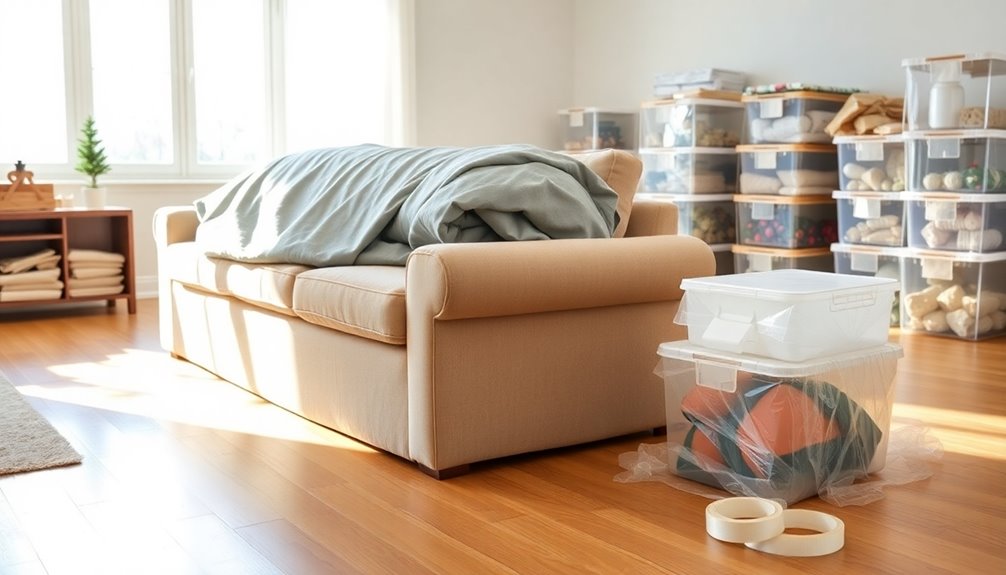
Preparing your sofa for seasonal storage requires careful attention to detail to ensure it stays in top condition. First, clean your sofa thoroughly to remove any dust, dirt, or stains that could become permanent. This step is crucial for maintaining the fabric's integrity and appearance.
Once it's clean, wrap your sofa completely in furniture pads. Make sure all surfaces are covered to prevent damage from moisture or pests. Using high-quality padding will provide an extra layer of protection.
Consider opting for climate-controlled storage. Extreme temperatures and humidity can warp or degrade your sofa's materials, so this investment is worth it. Additionally, place the sofa off the ground on pallets or a platform. This keeps it safe from potential moisture seeping in from the floor.
Don't forget to check on your stored sofa regularly. Inspect it for any signs of pests or moisture, and address any issues promptly to prevent further damage. By following these tips, you'll ensure your sofa remains in great condition, ready to be enjoyed when the season changes.
Conclusion
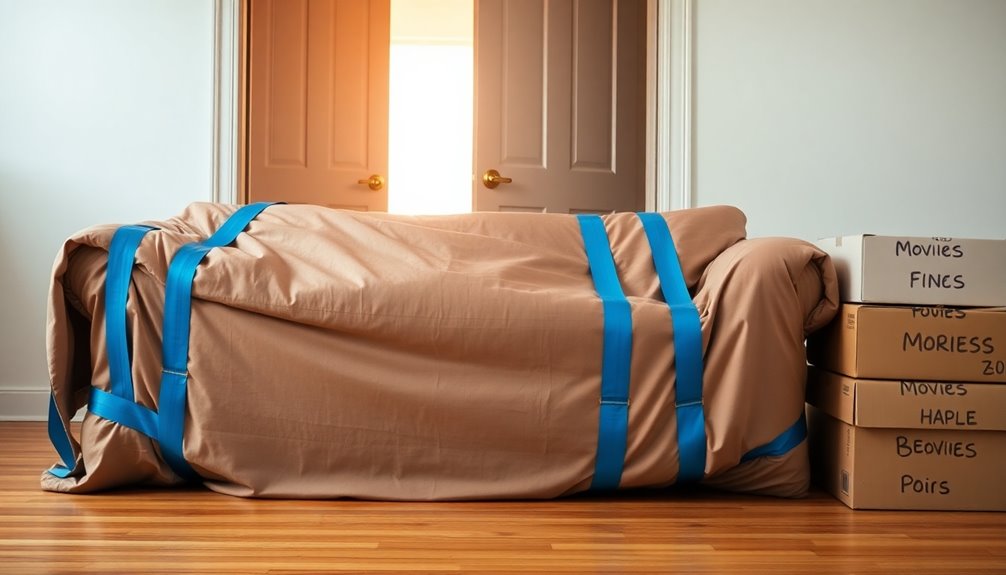
Successfully packing your sofa for moving is crucial to ensuring it arrives at your new home in pristine condition. By taking the time to properly wrap your sofa, you're protecting your investment and avoiding costly repairs or replacements. Start with multiple furniture pads, covering the entire back of the couch down to the floor. This ensures maximum coverage and protection against scratches and dents.
Next, utilize stretch wrap in an "X" pattern on the top and sides of the sofa. This enhances stability and keeps everything secure during transport. If your sofa has removable feet, take them off to avoid any potential breakage or scuffing. If you leave them on, make sure they're also well-protected.
Finally, double-check your wrapping job. Ensure that no material or padding is exposed, as this could lead to damage while moving. By following these steps, you're not just packing a piece of furniture; you're safeguarding it for the journey ahead. With a little effort and attention to detail, you'll make sure your sofa arrives at your new home just as beautiful as it was when it left. Happy moving!
Frequently Asked Questions
How to Pack a Couch for a Move?
When you're packing a couch for a move, start by covering it completely with furniture pads to protect it from damage. Use stretch wrap to secure the pads tightly, making sure it's snug but not overly tight. Adding an "X" pattern at the top helps keep everything in place. If you can, take off the couch feet to avoid scuffs, and wrap them separately if they stay attached. Double-check for full coverage before moving!
Can You Take Apart a Couch to Fit Through a Door?
Yes, you can often take apart a couch to fit through a door. Start by checking for removable parts like legs or cushions. If your couch is modular, it might come apart into smaller sections, making it easier to maneuver. Before disassembling, consult the manufacturer's instructions to avoid any damage. If disassembly isn't an option, consider using furniture sliders or lifting techniques to help navigate tight spaces.
How Do I Protect My Sofa When Moving House?
To protect your sofa when moving, start by wrapping it with furniture pads, covering all surfaces. Secure the pads with stretch wrap, applying it loosely at first, then tightening it for added protection. Use an "X" pattern with the wrap for stability. If possible, remove the sofa feet to prevent damage, and wrap them separately. Finally, inspect everything to ensure no parts are exposed, confirming the wrap is secure before you start moving.
What's the Easiest Way to Move a Heavy Couch?
To move a heavy couch easily, start by clearing the path to your destination. If possible, remove the couch’s feet to lighten the load and reduce the chance of damage. Grab a friend to help you lift it, using proper lifting techniques to avoid injury. Use furniture sliders to glide it across floors, or a dolly for easier transport. With teamwork and the right tools, you’ll make the move smoother and safer. If you’re unable to enlist the help of a friend, there are still ways to move furniture safely on your own. Consider using a lever and a block to tilt the couch, making it easier to slide it along the ground. Additionally, always take breaks if you feel strained, and rethink your strategy if the maneuver seems too challenging; your safety is the top priority.
